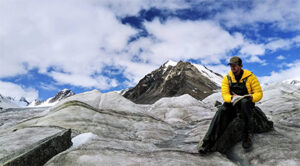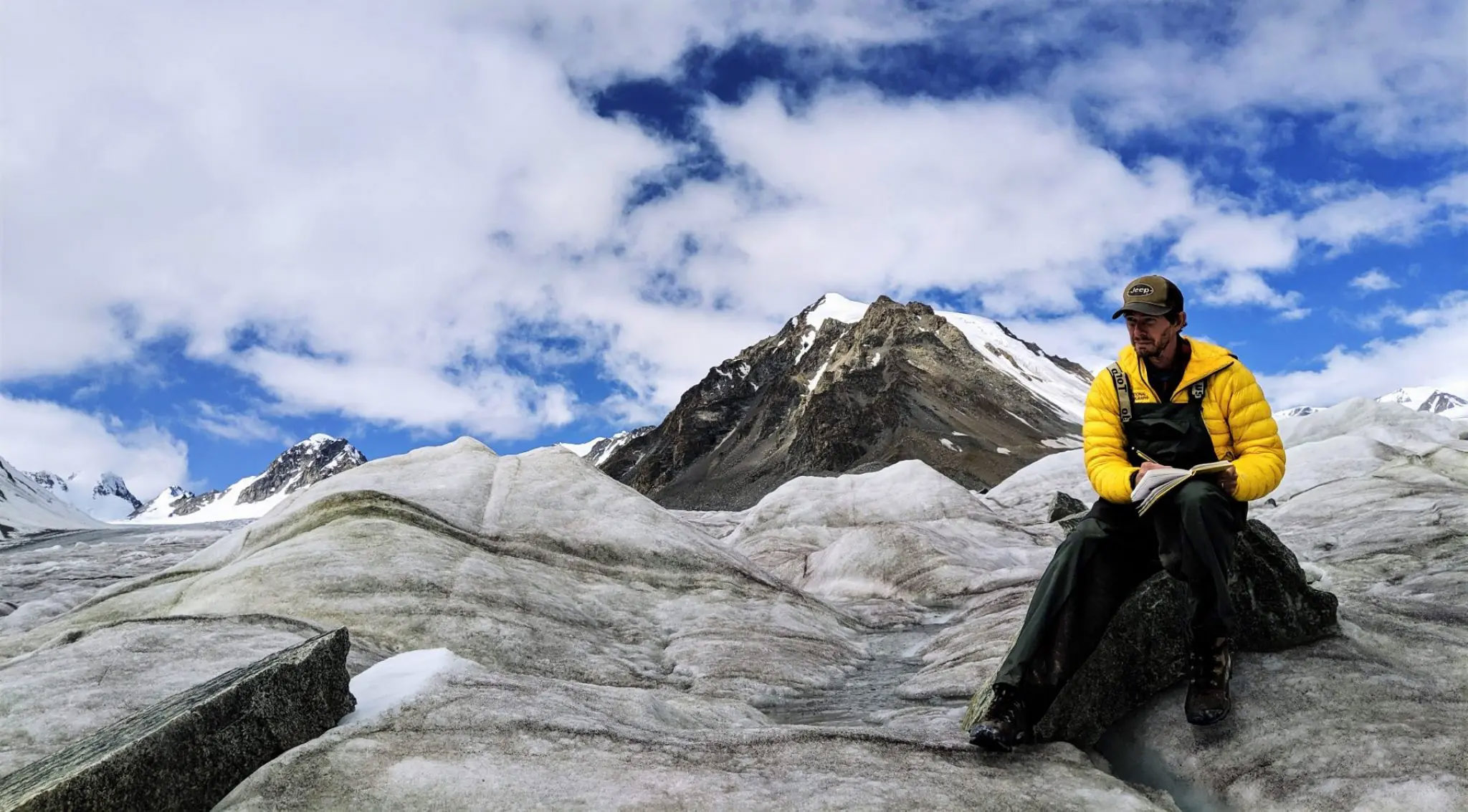
How Boulders in Mongolian Mountains Reveal the Pace of Climate Change
Expedition Date: July-August 2019
Field Team Members: Aaron Putnam, Peter Strand, Patricia Joyner (UMaine)
Expedition Funding Acknowledgement: National Science Foundation; Comer Family Foundation
Editor’s note: This article was produced in partnership with Northwestern University’s Medill School of Journalism, Media, Integrated Marketing Communications.
After sloshing through a soggy swampland, two glacial geologists, a high school teacher, three undergraduate science majors, a collection of Mongolian guides, and an embedded reporter—me—took turns shoveling the mud that buried the tires of our Toyota Tundra. While our feet sunk into storm-saturated muck, mosquitos attacked any exposed skin, and what had been blistering sunshine turned to rain, as a ceiling of clouds slowly rolled overhead.
The American team members had made the 24-hour journey from Maine to Chicago to China to Ulaanbaatar, Mongolia last summer to uncover clues that could reveal the pace of global warming since the end of the last ice age, or what scientists call the last glacial termination. A Toyota Tundra, a VW Touareg, and a Toyota Land Cruiser shuttled us from central to western Mongolia for a month of geological field work in the Altai Mountains, on the border of China and Russia.
After a successful week of sampling at a first field site, we prepared to set out for our next destination. Waking and crawling out of our technicolored tents to a perfect, crisp morning in the Tsagaan Gol Valley, we saw a sprinkle of powdered sugar snowfall delicately decorating the tips of the surrounding mountains.
After an hour of packing boxes, rolling sleeping bags, and organizing about two dozen canvas bags holding rock fragments that could contain clues about what caused the abrupt climate event that led to massive glacial melting at the end of the last ice age, we divided into three groups and piled into our three vehicles. In parts of the ensuing journey, we tilted almost completely sideways on ledges on mountains arching over roaring rivers. The high-speed road trip should have delivered us to our second campsite in under five hours.
That didn’t happen.
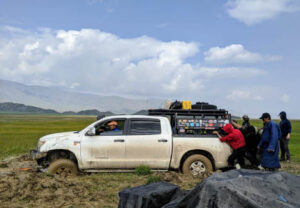
Instead, we encountered the gushing torrent that slices through Tsagaan Gol Valley. Glacial geologists Aaron Putnam and Peter Strand stood in matching yellow coats at the water’s edge, as our Mongolian drivers—Boldoo Baatar, Baysaa Todmandakh, and Bagi Gurkhlaajar—tied the pickup truck, VW, and Land Cruiser together with purple and orange towing rope. Despite the river’s daunting appearance, Baatar, the MacGyver of Mongolia, felt certain we could cross safely. Putnam wasn’t so sure, and he knew the river wasn’t our only problem.
During the first week of sampling, University of Maine freshman Patricia Joyner had fallen ill. After only one day in the field, she was suffering stomach cramps that left her curled in a ball of pain. Five days had passed; her condition had worsened. Putnam decided that the entire crew should put the field season on hold, not cross the river, and head instead to town, where Joyner could get immediate medical care.

That decision led the drivers to take an unfamiliar path, which caused both the Land Cruiser and the Toyota Tundra to get stuck, literally, in the mud and among the mosquitos where this story began.
Eventually, we dug out both cars and got Joyner to a hospital, where she received medication and was back on her feet the next day. But this isn’t a story about a road trip gone wrong or an undergraduate who got sick. This is a story about teamwork and hardship, and the people who dedicate their lives to traveling around the world in the hope of fitting a small piece into a much larger scientific puzzle. This is a story about what it takes to research climate change.
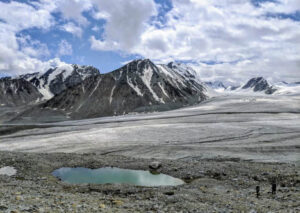
We’d spent the first week of the five-week field season on the edge of Mongolia’s Potanin National Park, putting in nine-hour days of hiking up and down sky-scraping mountains in search of boulders. Where most see large, unimpressive rocks, Putnam and Strand see clues about whether the transition from cold to warm climates around 18,000 to 20,000 years ago—that is, the transition from the last ice age to a climate similar to that of the present day—occurred simultaneously across hemispheres, or if the patterns differed. It appears they warmed together.
Putnam, an assistant professor at University of Maine’s School of Earth and Climate Sciences, has mentored Strand, a doctoral candidate, showing him the art of gathering global data for this project from places as distant as New Zealand, Tibet, and Nepal.
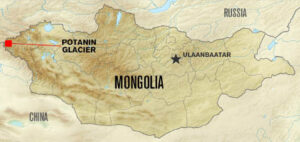
Before each trip, Putnam and his team search for locations around the globe where they know glaciers expanded during the peak of the last ice age. They find these locations by searching for moraines—landforms carved into the landscape by glaciers. Imagine setting a chunk of Play-Doh on a table and sticking your hand flatly in the center. As you add pressure, the dough under your hand sinks while the outer dough oozes up, creating a handprint. That’s similar to what happens to the earth as a glacier expands. It sits heavily on the flat ground or mountain side, pressing the surrounding landform upward, causing divots to form. Debris adds to the rising landscape with boulders and other sediments that get picked up by the glacier. When the climate warms and the glacier melts, receding from the outer edges in, these landforms remain, like the handprint in the Play-Doh. Some of the world’s largest of these handprints are now called the Great Lakes.
Thousands of years later, Putnam and Strand travel to such moraines to chip samples from the rocks that remain and then use a special chemical method to determine how long ago the glacier left them where they sit today. Using this calculation and identifying the distance between the debris position and where the glacier stands now allows them to determine the rate of warming in each region in past times, as compared to today. Collecting samples from Mongolia could reveal a lot of new information. There’s a wealth of data showing warming in the southern hemisphere in the time frame they are studying, but before Putnam and Strand’s work, very little was known about the warming patterns in the northern hemisphere. Without this information, it was difficult to know if warming and cooling occurred on a global or regional scale, compared to the current worldwide thrust of climate change.
Strand believes the lack of data in the northern hemisphere could be due to the difficulties that accompany sample collection in its less accessible parts. “There is a reason that not a lot of work has been done in interior Asia—in western Mongolia,” Strand said. “A lot of the low-hanging fruit has been plucked. The glaciers of Switzerland, or the Italian Alps—you can walk out of your bed and breakfast and be on a moraine in 20 minutes. And then for lunch you can go out to a cafe and get a latte,” he said. “That is so far removed from doing fieldwork in a place like Mongolia.”
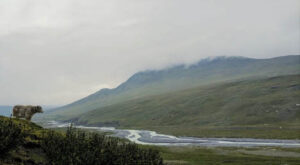
A Mongolian field season substitutes bed and breakfasts and lattes with four-season tents and instant coffee. Bathrooms mean squatting behind boulders; “showers” are accomplished by baby wipe. The central aspect of food is butchered lamb; body parts dangle from a wire above the dining table until the day they’re cooked.
This is Putnam’s fourth trip to Mongolia and Strand’s third. In previous years they’d dedicated their time to collecting the most significant samples—those closest to the Potanin Glacier, Mongolia’s largest, and those at what they suspect are locations the glacier occupied in its largest form, at the peak of the last ice age.
“We’ve already done some sampling. We already have an idea of what’s out there. Now we’re just looking to fill in some of the holes,” said Strand.
The samples they’ve already studied from trips around the world hint that the shift in climate was not only synchronous in both hemispheres, but also occurred at a much faster rate than many previously suspected. “We had always had this conception that it was a slow process, but as we acquire more data, we developed a clearer picture of how glaciers behaved, and we realized that it was a really sudden event,” said Putnam. “It was so fast that you would have noticed it.”
Those living near the Potanin today are noticing the current warming, paced by the push of fossil fuel consumption that escalates carbon dioxide emissions, the thermostat of climate change.

When humans age, the skin around their eyes crinkles, lines form above their brows, sunspots appear on hands. When a moraine ages, its land solidifies, boulders settle into place, and vegetation takes root. Our first field site was located about 30 kilometers from the Potanin Glacier. The distance from the glacier and the formation’s sturdiness and green appearance were enough to tell Putnam and Strand that the landform is quite old.
The moraines leading to the valley below our second campsite in Potanin National Park looked like boulder-covered sand dunes. The rocks painted the hillside in neutral tones of off-white and golden brown. Across from our camp site stood a wall of mountains, each topped with its own shimmering snowcap. Before we left the national park, Putnam and Strand decided, the group should walk on a glacier.
As we headed toward the glacier, with each step, young moraines shifted below our feet, sending pebbles ricocheting downward. Slips and missteps left knees bruised and shins swollen. As we stepped onto the massive chunk of ice and began walking away from its edges, the surface turned cloudy white. Snaking in and out of the Potanin Glacier, melting water left streams that dipped into holes of darkness in a rumble of thrashing falls.
Ghana Gantulga, a guide from Putnam and Strand’s 2016 Mongolian expeditions who has lived in Potanin National Park for the past 48 years, greeted us at camp that evening and told us some intriguing news. One of the moraines, which is about 500 meters beyond the modern-day Potanin Glacier, represents where the glacier was about 30 years ago, he said. If true, it means that the glacier has undergone quite a bit of retreat in a short time.
There’s a way to verify Gantulga’s claim. It’s how Putnam and Strand track all glacial movement. They use boulder fragments, whose atomic makeup and location on a landform left behind by the glaciers of the last ice age reveal where those glaciers sat before receding as the climate warmed. How that revelation is calculated—well, that’s its own scientific story.
The galaxy in which Earth resides, the Milky Way, is full of supernovas—stars dying in an explosion of light and energy. These explosions are powerful enough to break apart the highly energetic atomic nucleus (the small, dense region at the center of an atom containing positively charged protons and chargeless neutrons) and hurl subatomic debris through space at near light speed. These subatomic particles, often called cosmic rays, hit the Earth’s atmosphere in a shower of mostly protons and rain down streams of secondary particles that interact with the quartz found in rocks. As the particles interact with the quartz, composed of one-part silicon and two-parts oxygen, they break apart the silicon and oxygen and leave behind beryllium-10, a form of the metal beryllium.
That’s the only way beryllium-10 is formed on Earth. The longer the rock is exposed to the atmosphere, and therefore cosmic rays, the higher the concentration of beryllium-10.
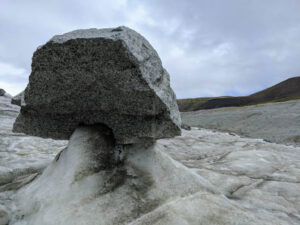
Although glaciers appear to be immobile chunks of ice and snow, they constantly move, flowing downward while growing during ice ages. This means that anything that gets caught in a glacier slowly churns toward the ice’s perimeters as if caught inside a conveyor belt.
That’s what happened to the boulders Putnam and Strand sampled from. While trapped, the glacier smoothed the rocks, giving them a more polished texture and removing the outer surface containing the beryllium-10.
When the climate warmed, the outermost edges of all glaciers began to melt and retreat, leaving behind the boulders contained within the ice and once again exposing them to the subatomic particles streaming down from the interaction between cosmic rays and the Earth’s atmosphere.
So beryllium-10 started forming again.
By the time Putnam, Strand, and their crew hiked up mountains laden in wildflowers or splashed through grassy wetlands in search of these boulders, the beryllium-10 concentration had built up enough to create an extremely precise time stamp. By determining the number of years that have passed since the boulder began developing beryllium-10 and comparing its location to the current position of the glacier that churned it out, Putnam and Strand can figure out the speed at which glaciers are retreating in the age of man-made climate change.
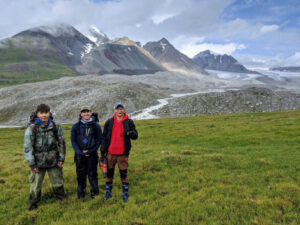
On our first day of sampling, we stood at the bottom of a mountain that our early ancestors climbed thousands of years ago. Where they carried sharpened tools and used them to peck petroglyphs of horses, goats, and men into the mountain’s bedrock, the team of scientists and undergraduate students from the University of Maine and the Mongolian University of Science and Technology carried hiking packs, each filled with a power drill, a hammer, metal shims, and metal wedges.
After hiking what from the ground appeared to be a short distance but ended up being a very difficult hour of climbing, Strand found a boulder and instructed everyone to feel the surface for glacial polish. The group crowded the boulder, placing hands and rubbing the boulder like a fortune teller would her crystal ball.
After drilling, inserting shims and wedges into the drilled holes, and hammering the shims until a rock sample separated with a satisfying crack, the group packed up and moved on to other boulders.
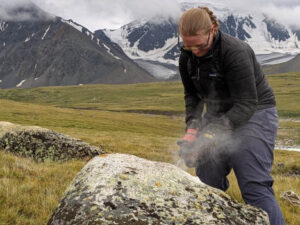
Scientists have understood for some time that the Earth fluctuates between warm and cold climates. Modern ice ages, or glacial periods, occur once every 100,000 years or so, followed by intermediate warming, or interglacial periods.
There are a few hypotheses for the triggers of climate change in the past.
The first hypothesis relates to the changes in the Earth’s orbit around the sun. About every 100,000 years the orbit of the Earth around the sun shifts from a more-circular to a more-oval path. The distance to the boundaries of an oval path leave the Earth farther from the sun, contributing to changes in the Earth’s climate.
If long-term orbital eccentricity were the sole cause of ice ages, Strand says, “the transition into an ice age and out of an ice age would be expected to be gradual.” That’s because the variation in the curve of the Earth’s orbit occurs slowly over 100,000 years. Yet Putnam and Strand’s research, which builds on findings over the past 10 to 20 years, shows that the climate changes rapidly. Basing ice ages on the rotation and tilt of the Earth on its axis also would mean the northern and southern hemispheres experience warm and cold periods at opposite times. “However, that is not the case,” said Strand. “Ice ages appear to be globally synchronous. So, when the northern hemisphere is cold, the southern hemisphere is cold. And they appear to warm together.”
Because orbital and axis factors alone cannot account for ice ages and the warm periods between them, Putnam and Strand’s scientific predecessors needed to figure out what could cause both hemispheres to warm and cool at the same time. The answer—at least in terms of the human factor—is greenhouse gas, and specifically, carbon dioxide, the natural concentration of which is roughly the same around the globe. Glacial and interglacial periods correspond closely with atmospheric carbon dioxide levels. That means when the Earth has experienced warm periods in the past, carbon dioxide levels were high; when the Earth experienced cool periods, carbon dioxide levels were low. This fluctuation is a natural Earth cycle.
What isn’t natural is the drastic rise in carbon dioxide emissions over the past 100 years—a phenomenon that, most scientists agree, is the only supportable explanation for the pace of current climate change. Before the introduction of widespread anthropogenic factors, atmospheric carbon dioxide levels remained between roughly 200 and 300 parts per million, falling to about 200 in the ice ages and rising to almost 300 in the warming spells across one million years. Levels rose with the onset of the industrial revolution, reaching about 320 parts per million in the 1960s. Today, atmospheric carbon dioxide has reached an all-time high of more than 400 parts per million, and it’s continuing to rise.
Putnam and Strand agree that an increase in atmospheric carbon dioxide is a large contributor to the warming climate. But they want to know what caused the climate to warm and cool all on its own before humans had a hand in increasing greenhouse gas emissions. “There are these huge changes that the Earth is capable of. And they’re unexplained. And then, you superimpose on that problem the changes that we’re creating now [with increased carbon dioxide emissions],” Strand said. “We’re pushing [the planet] to an even further extreme. We don’t have a great understanding of the natural variability, and that means that we can’t possibly have a great understanding of the changes that we are creating and what the consequences of them will be.”
Before the disastrous day of the overflowing river, the swampy bog, and the hospital visit; before five nauseating days traveling along dipping and winding dirt roads and scaling mountain ledges on the way to our first campsite; and certainly before our flight from Chicago, to China, and on to Mongolia, I thought conducting fieldwork in the Altai Mountains would be easy. I had a misconception that I believe most non-scientists share: Scientists pick a location for field work, they travel to said destination, they collect their data, they return home, and they get results.
My initial expectation overlooked the first-world luxuries we would give up in the field, including running water, expansive food selections, the ability to stay in constant contact with loved ones, and the means to speak a country’s language and convey gratitude toward those who’ve helped you. “One component that gets overlooked … is just how much work goes into collecting a small amount of data,” Strand said at the end of the field season. “I’m talking about writing the grants, getting the money, organizing the trip, getting the permits, doing the logistics … driving across the country … eating boiled sheep, living in a tent, sampling in the rain because we only have two days, and it’s just going to rain.”
As Strand spoke, we drove, watching mountains slip into cattle-covered valleys. Occasionally, we’d be stopped by a herd of screeching goats that stood wide-eyed and confused in the middle of the road until the car was just close enough to hit them. Then they would spring away, disgruntled, tails erect. We’d spent days in that car, snacking on trail mix and Snickers bars, sharing stories, and becoming friends.
“In the grand scheme of things, we will create a chronology that is really just scratching the surface of Mongolian glacial geology. And we’ll produce some dates, and [they] will fit into this global scheme.… But it was not easy. It’s not easy to get those few data points,” Strand said.
Despite the difficulties inherent in their type of research, Putnam and Strand are already planning more of it. They know that climate change has happened abruptly in the past, and the possibility that it could happen even more abruptly now has reinforced the urgency of their efforts to put together the pieces of the global climate change puzzle, weathered rock by weathered rock.
